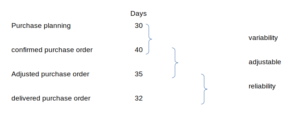Calculating supply chain lead time
Calculating the total supply chain lead time, from supplier to customer, and the breakdowns often leads to confusion within organizations.
Lead time is important to be able to control the total production process. Directly for planners at the various levels in an organization, but also for management and Sales. Control over lead time implies insight into the reliability of your supply chain.
Lead time definitions
- Order : from receipt of the customer order until the order has been fully processed and delivered to the customer
- Procurement : time needed for creating a procurement order up to and including receipt of the goods
- Production : Starts at release of production order up to and including delivery of finished product for shipping / storage
- Delivery: being available from order ex-production to delivery to the customer.
- supply chain : total time from customer order to delivery to customer.
The above definitions are the most common lead time. Obviously there are more lead times to define. Such as order handling lead time: from receipt of customer order until order is ready for planning. [Order entry + order receipt]
Cycle time
What is often confused is the concept of cycle time versus lead time. In the case of lead time, this refers to the total lead time of a process. Cycle time is the time it takes to complete 1 process cycle. Also defined as : Also known as the production time of 1 product including waiting times within the cycle. Cycle time thus focuses on efficiency of the production process. Cycle time is therefore part of the total lead time.
Within cycle time we distinguish between 3 subtypes.
- Maximum allowable cycle time. Often this is set to 92%-95% of the takt time. Some buffer is therefore built in to accommodate unforeseen variability. This cycle time therefore determines the pace of the production line and therefore the delivery to the customer.
- Designed or net cycle time. At this time, the process functions as designed and intended. So without delays.
- Current cycle time. This is the actual measured time of the process
Takttime
A third measurement of time is Takttime, which stems from the Lean philosophy. Takt time is the rate at which the customer receives the products from the process. In formula: total available production time / average customer demand.
Calculations
Since lead time is expressed in days or equivalents, it is not difficult to make the calculations between 2 moments. What is important is time moments you define.
When determining, for example, the procurement lead time, it is important whether you have agreed a fixed lead time with the suppliers. [procurement lead time is eg 30 days] It is also possible that you have a different desired date for receipt. This is the case with on-demand orders. In addition, there is the option that the supplier uses different lead time depending on the product and its production capacity. Then you will have to ask for a confirmed delivery date.
Since single measurement is often not possible, the total lead time is calculated by adding the various variables together:
Replenishment leadtime manufacturering= production leadtime + procurement leadtime + shipping leadtime
Replenishment lead time procurement = procurement lead time + shipping lead time
To fully calculate leadtime from supplier to customer: leadtime procurement + leadtime manufacturering + delivery time to customer.
Related links:










